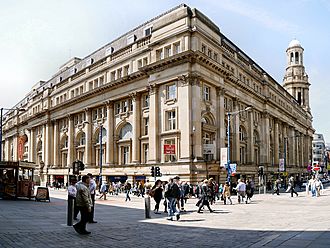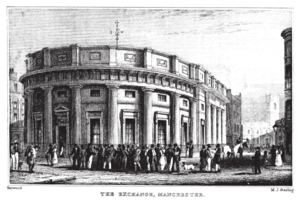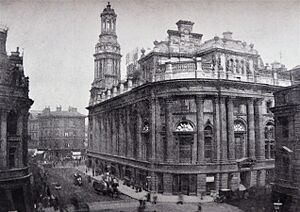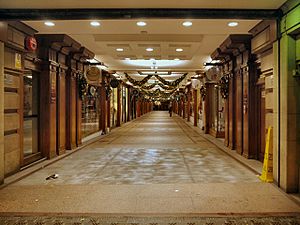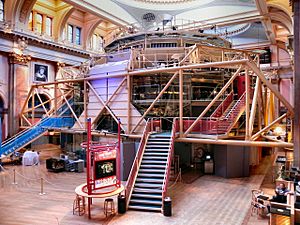Royal Exchange, Manchester facts for kids
The Royal Exchange is a very important building in Manchester, England. It is a grade II listed building, which means it's protected because of its special history and design. You can find it right in the city centre, surrounded by busy streets like St Ann's Square and Market Street. Today, the building is home to the famous Royal Exchange Theatre and a shopping centre.
This building has a long history. It was badly damaged twice: once during the Manchester Blitz in World War II and again in 1996 due to a large explosion. The Royal Exchange you see today is the last of several buildings on this spot. They were all used for trading goods, especially cotton and other fabrics.
Contents
A Look Back: From 1729 to 1973
Manchester became famous for its cotton industry. Raw cotton came from places like Liverpool, and then Manchester turned it into yarn and finished cloth. The Royal Exchange was where people traded these cotton products with buyers from all over the world.
Manchester's first trading exchange opened in 1729, but it closed down later. As the cotton business grew bigger, people realized they needed a new, larger place to trade.
The First Grand Exchange (1809)
A new exchange was designed by Thomas Harrison and opened in 1809. It was built in a grand Classical style using Runcorn stone. The building had two floors above a basement. It cost £20,000, which was a lot of money back then!
The main trading room was huge, covering 812 square yards. There was also a library with over 15,000 books for members. In the basement, a newsroom was lit by a dome. This new exchange opened to celebrate the birthday of King George III.
Growing Bigger: The Later Exchanges
As the cotton trade kept expanding, the exchange needed more space. It was made bigger in 1849. Later, a third exchange was built between 1867 and 1874. This one was designed by Mills & Murgatroyd.
It was made even larger between 1914 and 1931 by Bradshaw Gass & Hope. This created the biggest trading hall in England! It had three domes and was twice the size of the hall you see today. On trading days, merchants and brokers made deals that supported thousands of textile workers. Manchester became known as "Cottonopolis" because of its huge cotton trade.
Damage and Change
During World War II, the Royal Exchange was seriously damaged. A bomb hit it directly during a German air raid in 1940. The inside was rebuilt, but with a smaller trading area. The top part of the clock tower was also destroyed and replaced with a simpler design.
Trading stopped completely in 1968. For a while, it looked like the building might even be torn down.
Building Design: Architecture of the Royal Exchange
The Royal Exchange is a large building with four main floors and two attic floors. It's built from Portland stone and designed in the Classical style. The roof has three glass domes.
On the ground floor, you'll find an arcade (a covered walkway with shops). The building also has a central open space called an atrium on the first floor. The outside of the building features strong, block-like pillars on the ground floor. The upper floors have fancy Corinthian columns and decorative edges.
At the north-west corner, there's a unique Baroque-style tower called a turret. The main entrance on the west side has a huge arched doorway with wide steps leading up to it.
The Royal Exchange Theatre
The building was empty until 1973 when a theatre company started using it. The Royal Exchange Theatre officially opened in 1976. It was founded by five artistic directors: Michael Elliott, Caspar Wrede, Richard Negri, James Maxwell and Braham Murray. The famous actor Laurence Olivier opened the theatre on September 15, 1976.
The 1996 Explosion and Reopening
On June 15, 1996, the building was damaged again when a large explosion happened nearby. The blast caused the theatre's dome to move, but the main structure stayed strong. Repairs took over two years and cost £32 million, with money coming from the National Lottery.
While the building was being fixed, the theatre company performed in a different location. The refurbished theatre reopened on November 30, 1998, with Prince Edward attending. The first play performed was Hindle Wakes, which was supposed to open on the day of the explosion.
After the repairs, the theatre gained a second performance space called the Studio. It also added a bookshop, craft shop, restaurant, and bars. In 1999, the Royal Exchange was named "Theatre of the Year" for its amazing refurbishment and new season of plays.
Inside the Theatres
The main theatre is very special. It's a seven-sided structure made of steel and glass that sits inside the building's Great Hall. It's a true "theatre in the round," meaning the stage is surrounded by seats on all sides. This unique design helps actors and the audience feel very connected.
Because the floor couldn't hold the theatre's weight, the 150-ton structure is actually hung from four columns that support the hall's central dome. Only the stage and ground-level seats touch the floor. This amazing theatre opened in 1976.
The main theatre can seat up to 800 people on three levels, making it the largest theatre in the round in the world. There are 400 seats on the ground floor and two upper levels, each with 150 seats.
The Studio is a smaller theatre with 90 seats. It has no fixed stage, so the seats can be moved around for different types of shows. It hosts visiting theatre companies, comedians, and performances for young people.
What Plays Are Performed?
The Royal Exchange puts on about 350 performances a year, including nine professional theatre productions. They perform a wide variety of plays, from classic works by Shakespeare and Ibsen to new plays.
They also host concerts, discussions, and literary events. The theatre works with children and teens, offering drama activities and groups. These young performers even get to be in shows like "The Freedom Bird" and "The Boy Who Ran from the Sea."
Famous Productions
The theatre has put on many highly praised and award-winning plays. They have performed 31 Shakespeare plays and over 100 new plays for the first time ever. Some well-known productions include:
- The Rivals (1976) with Tom Courtenay
- The Lady from the Sea (1978) with Vanessa Redgrave
- The Dresser (1980), a world premiere
- The Duchess of Malfi (1980) with Helen Mirren and Pete Postlethwaite
- Waiting for Godot (1980)
- Hamlet (1983) with Robert Lindsay
- Moby Dick (1984), a world premiere
- As You Like It (1986) with Janet McTeer
- All My Sons (1988) with John Thaw
- Romeo and Juliet (1992) with Michael Sheen
- Hindle Wakes (1996 and 1998) with Sue Johnston
- Peer Gynt (1999) with David Threlfall
- The Homecoming (2002) with Pete Postlethwaite
- Othello (2002) with Paterson Joseph and Andy Serkis
- On the Shore of the Wide World (2005), an Olivier Award winner
- The Children's Hour (2008) with Maxine Peake
- Punk rock (2009), a world premiere with Tom Sturridge
- A Raisin in the Sun (2010) with Ray Fearon
- Miss Julie (2012) with Maxine Peake
- A Doll's House (2013) with Cush Jumbo
- Sweeney Todd (2013)
- Hamlet (2014) with Maxine Peake
- Sweet Charity (2016)
The Bruntwood Prize
In 2005, the Royal Exchange Theatre started the Bruntwood Playwriting Competition. This competition encourages new playwrights from the UK and Ireland. It has helped many new writers get their plays noticed and performed. The winning play in 2006 was Pretend You Have Big Buildings, and the writer received £15,000.
Important People at the Theatre
The Royal Exchange Theatre has always been run by a team of artistic directors who share a common vision for theatre. These directors have included:
- Michael Elliott (1976–1984)
- James Maxwell (1976–1995)
- Braham Murray (1976–2012)
- Caspar Wrede (1976–1990)
- Greg Hersov (1987–2014)
- Marianne Elliott (1998–2002)
- Sarah Frankcom (2008–2019), who became the sole artistic director in 2014.
- Bryony Shanahan (2019–2023)
- Roy Alexander Weise (2019–2023)
Famous Actors
Many great actors have performed at the Royal Exchange over the years. Some actors have appeared in many different shows, like Brenda Blethyn, Tom Courtenay, Cush Jumbo, Robert Lindsay, Ian McDiarmid, Maxine Peake, Pete Postlethwaite, Andy Serkis, and David Threlfall.
Other famous actors who have performed here include Brian Cox, Albert Finney, Helen Mirren, David Morrissey, Gary Oldman, Vanessa Redgrave, John Thaw, and Julie Walters.
The theatre is also known for finding young actors before they become famous. Stars like Kate Winslet, Hugh Grant, David Tennant, Michael Sheen, and Andrew Garfield all performed at the Royal Exchange early in their careers.
Images for kids


